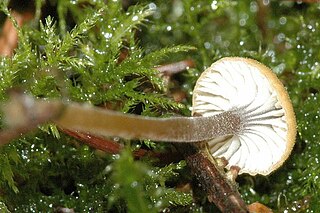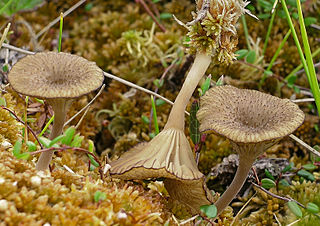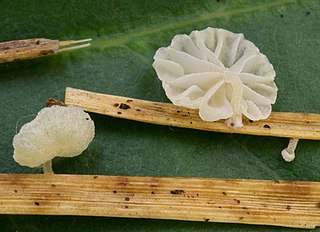
The Agaricales are an order of fungi in the division Basidiomycota. As originally conceived, the order contained all the agarics, but subsequent research has shown that not all agarics are closely related and some belong in other orders, such as the Russulales and Boletales. Conversely, DNA research has also shown that many non-agarics, including some of the clavarioid fungi and gasteroid fungi belong within the Agaricales. The order has 46 extant families, more than 400 genera, and over 25,000 described species, along with six extinct genera known only from the fossil record. Species in the Agaricales range from the familiar Agaricus bisporus and the deadly Amanita virosa to the coral-like Clavaria zollingeri and bracket-like Fistulina hepatica.

The Marasmiaceae are a family of fungi in the order Agaricales. Basidiocarps are most frequently agarics, but occasionally cyphelloid. According to a 2008 estimate, the family contained 54 genera and 1590 species, but molecular research, based on cladistic analysis of DNA sequences, has led to a more restricted family concept, so that the Marasmiaceae included just 13 genera, and some 1205 species. It was reduced further down in 2020, to 10 genera and about 700 species.

The Hygrophoraceae are a family of fungi in the order Agaricales. Originally conceived as containing white-spored, thick-gilled agarics, including Hygrophorus and Hygrocybe species, DNA evidence has extended the limits of the family, so it now contains not only agarics, but also basidiolichens and corticioid fungi. Species are thus diverse and are variously ectomycorrhizal, lichenized, associated with mosses, or saprotrophic. The family contains 34 genera and over 1000 species. None is of any great economic importance, though fruit bodies of some Hygrocybe and Hygrophorus species are considered edible and may be collected for sale in local markets.
Camarophyllopsis is a genus of agarics in the family Clavariaceae. Basidiocarps are dull-coloured and have dry caps, rather distant, decurrent lamellae, white spores, and smooth, ringless stems. In Europe species are characteristic of old, unimproved grasslands which are a declining habitat, making them of conservation concern.

Rickenella is a genus of brightly colored bryophilous agarics in the Hymenochaetales that have an omphalinoid morphology. They inhabit mosses on mossy soils, peats, tree trunks and logs in temperate regions of both the Northern and Southern Hemispheres. Phylogenetically related agarics are in the genera Contumyces, Gyroflexus, Loreleia, Cantharellopsis and Blasiphalia, as well as the stipitate-stereoid genera Muscinupta and Cotylidia. and the clavarioid genus, Alloclavaria.

Omphalina is a genus of small agarics with white, nonamyloid, basidiospores and decurrent gills. Typically the cap has a deep central depression giving the umbrella-like to funnel-shaped cap the appearance of a belly button, or a belly with a navel. Similarly-shaped agarics are said to be omphalinoid in appearance.

Gerronema is a genus of small- to medium-sized lignicolous agarics with white, nonamyloid, spores and decurrent gills. The genus was circumscribed by American mycologist Rolf Singer in 1951.

Lichenomphalia is both a basidiolichen and an agaric genus. Most of the species have inconspicuous lichenized thalli that consist of scattered, small, loose, nearly microscopic green balls or foliose small flakes containing single-celled green algae in the genus Coccomyxa, all interconnected by a loose network of hyphae. The agaric fruit bodies themselves are nonlichenized and resemble other types of omphalinoid mushrooms. These agarics lack clamp connections and do not form hymenial cystidia. The basidiospores are hyaline, smooth, thin-walled, and nonamyloid. Most of the species were originally classified in the genera Omphalina or Gerronema. Historically the species were classified with those other genera in the family, the Tricholomataceae together with the nonlichenized species. Lichenomphalia species can be grouped into brightly colored taxa, with vivid yellow and orange colors, versus the grey brown group, depending upon the microscopic pigmentation deposits. Molecular research comparing DNA sequences now place Lichenomphalia close to the redefined genus Arrhenia, which together with several other genera not traditionally considered to be related, fall within the newly redefined Hygrophoraceae.

The Physalacriaceae are a family of fungi in the order Agaricales. Species in the family have a widespread distribution, ranging from the Arctic, (Rhizomarasmius), to the tropics, e.g. Gloiocephala, and from marine sites (Mycaureola) and fresh waters (Gloiocephala) to semiarid forests (Xerula).

Resinomycena is a genus of fungi in the mushroom family Mycenaceae. The genus contains at least eight species found in North America, Europe and eastern Asia. This genus of small white to tan colored agarics is saprophytic and colonizes leaf litter, bark, small twigs and decaying monocot vegetation. The fruitbodies are small and resemble Mycena or Marasmius or Hemimycena and are distinguished by amyloid spores, poorly dextrinoid tissues, and the abundant oily, resinous cystidia on the pileus, lamellae edges and stipes. One recently described species, Resinomycena fulgens from Japan that is a synonym of Resinomycena japonica, has luminescent fruitbodies.

Aphroditeola is an agaric fungal monotypic genus that produces pink cantharelloid fruit bodies on coniferous forest floors. The lamellae are forked and typically the fruit bodies have a fragrant odor described as candy-like, cinnamon-like or pink bubble gum-like.

Mycopan is one of several genera of agaric fungi (mushrooms) that were formerly classified in the genus Hydropus or Mycena. Mycopan is currently monotypic, containing the single species Mycopan scabripes. It produces dusky colored fruit bodies that are mycenoid, but lack amyloid or dextrinoid tissues except for the amyloid basidiospores. Its stipe is notably scruffy from cystidioid end cells and unlike true Hydropus it does not bleed clear fluid. Phylogenetically, Mycopan is distant from the Mycenaceae and the type of that family, Mycena, and it is not with the type of Hydropus, Hydropus fuliginarius. Mycopan grouped closest to Baeospora. Baeospora was shown to be in the Cyphellaceae by Matheny and colleagues. Mycopan scabripes grows from debris in forest floors in North America and Europe.

Lichenomphalia umbellifera, also known as the lichen agaric or the green-pea mushroom lichen, is a species of basidiolichen in the family Hygrophoraceae. L. umbellifera forms a symbiotic relationship with unicellular algae in the genus Coccomyxa. It is regarded as nonpoisonous.
Flammula is a dark brown-spored genus of mushrooms that cause a decay of trees, on whose bases they often fruit, forming clusters of yellowish brown mushrooms.
Sphagnurus is a parasitic mushroom genus in the family Lyophyllaceae that creates conspicuous dead patches on peat moss (Sphagnum) in bogs. The genus contains one species known to inhabit Eurasia and North America. Phylogenetically the genus is closest to, but is isolated from species now classified in the genus Sagaranella Prior to molecular analyses, the most recent classification put it in the genus Tephrocybe, but that genus is allied to Termitomyces.

Myochromella is a mushroom genus in the family Lyophyllaceae that has been segregated from both Lyophyllum and Tephrocybe using molecular analyses and was first informally labelled clade 'mycochromella' or section 'Tephrophana p.p.' before being recognized as a genus. The species resemble grey colored Collybias and grow in forests.

Arrhenia chlorocyanea, commonly known as the verdigris navel, is a species of agaric fungus in the family Hygrophoraceae. Originally named as a species of Agaricus in 1885, and later classified as a member of Omphalina, the species was transferred to the genus Arrhenia in 2002. It is found in Europe and North America.

Lichenomphalia chromacea is a species of basidiolichen in the family Hygrophoraceae. It is found in southern Australia. The yellow-orange fruiting bodies of the species are mushroom-like, with a cap width of typically less than 4 cm. The thallus of the lichen is a greenish, granular layer of fungal hyphae and algae on the soil around the base of the stipe.

Lichenomphalia hudsoniana is a species of basidiolichen in the family Hygrophoraceae. It is widely distributed in alpine and arctic regions of the world, where it grows on moist soil amongst moss.















